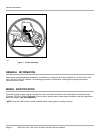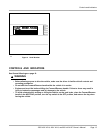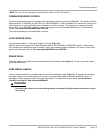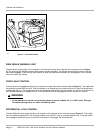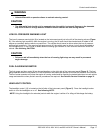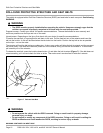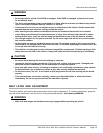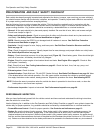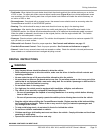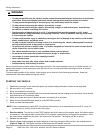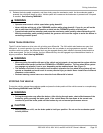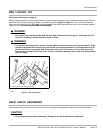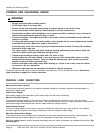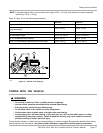
Pre-Operation and Daily Safety Checklist
PRE-OPERATION AND DAILY SAFETY CHECKLIST
Each vehicle has been thoroughly inspected and adjusted at the factory; however, upon receiving your new vehicle(s),
you should become familiar with the controls, indicators, and operation. Carefully inspect each vehicle to ensure that it
is in proper working condition before accepting delivery.
Use the following list as a guide to inspect the vehicle. This list should be used daily and in conjunction with the
Performance Inspection on page 20 and the Periodic Service Schedule on page 31 to ensure that the vehicle is in
proper working condition. Any problems should be corrected by a dealer/distributor or a trained technician.
• General: All the parts should be in place and properly installed. Be sure that all nuts, bolts, and screws are tight.
Check hose clamps for tight t.
• Safety and information decals: Check to ensure that all safety and information decals are in place and can be
read easily. See Safety Decal and Feature Identication on page 5.
• ROPS: Check to ensure the ROPS is not damaged and all hardware is secure. See Roll-Over Protective
Structure and Seat Belts on page 18.
• Seat belts: Visually inspect for cuts, fraying, and loose parts. See Roll-Over Protective Structure and Seat
Belts on page 18.
• Tires: Check for proper tire pressure. Visually inspect tires for wear, damage, and proper ination on a daily basis.
See Vehicle Specications on page 48.
• Battery: Check electrolyte to ensure it is at the proper level (Figure 30). Check battery posts. Wires should be tight
and free of corrosion, and battery should be fully charged.
• Engine: Check for proper engine oil and coolant levels and leaks. See Engine Oil on page 35. Check air lter
and replace if necessary.
• Fuel: Check fuel level. See Fueling Instructions on page 43. Check fuel tank, lines, fuel cap, pump, and
fuel lters for fuel leakage.
• Exhaust system: Check for leaks.
• Hydraulic brakes: Check uid level. Fill with DOT 5 brake uid only. See Brake Fluid Reservoir on page 34. Wear
in the brakes before initial vehicle operation. On a at, open surface, accelerate the vehicle to moderate speed,
then apply the brakes under modest, steady pressure. Repeat this procedure ve times. See following NOTE.
NOTE: Perform the wear-in procedure when the vehicle has been in operation for less than a week, or when the
brake pads or rotor have been replaced.
• Performance Inspection: Inspect as instructed. See Performance Inspection on page 20.
PERFORMANCE INSPECTION
After you have familiarized yourself with the vehicle controls and have read and understood the driving instructions,
take the vehicle for a test drive.
Use the following list, in addition to the Pre-Operation and Daily Safety Checklist on page 20, as a guide to inspect the
vehicle daily for proper operation. Any problems should be corrected by a dealer/distributor or a trained technician.
• Forward/Reverse Control: Check for proper operation. See Controls and Indicators on page 13.
• Brakes: Be sure the brakes function properly. When brake pedal is fully pressed under moderate pressure, the
vehicle should come to a smooth, straight stop. If the vehicle swerves or fails to stop, have the brake system
checked and serviced as required. When the brake pedal is fully pressed under heavy pressure, the pedal should
feel rm and the distance between the back of the pedal and the oorboard should be a minimum of 1.25 inches (3.2
cm). Brakes must be maintained so the brake pedal cannot be pressed to the oorboard under any circumstance.
Page 20 2009 HUV 4214, HUV 4414, andHUV 4414-XP Owner’s Manual



